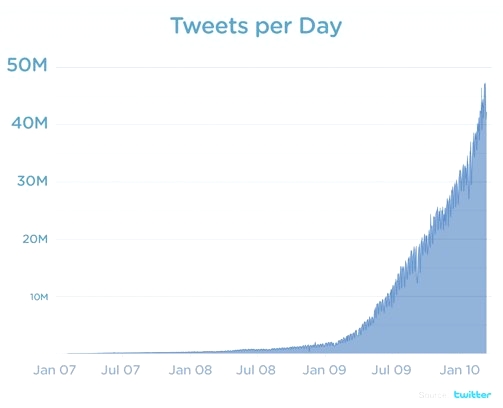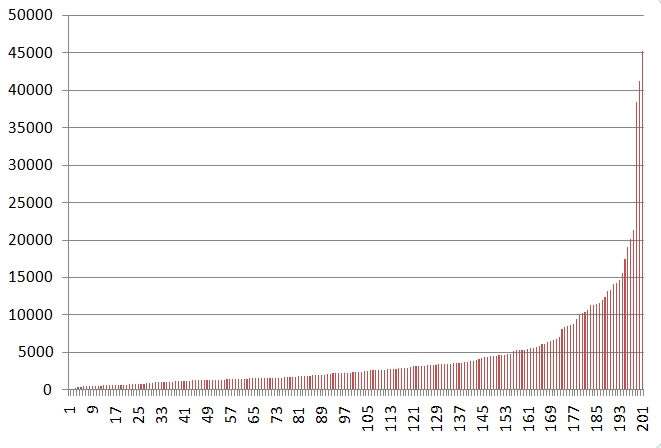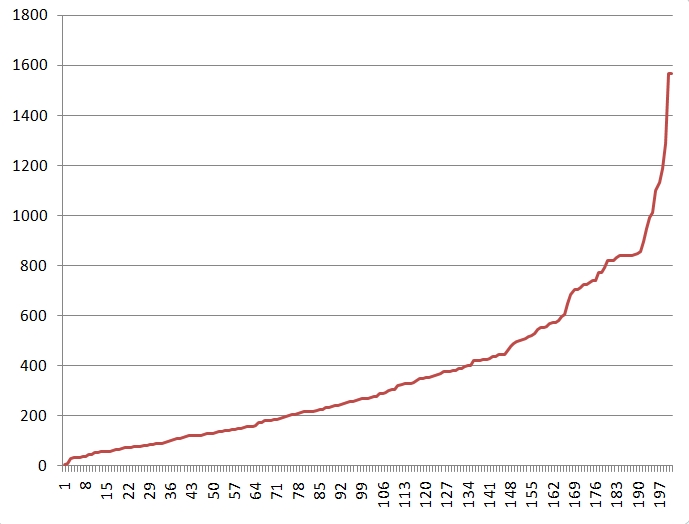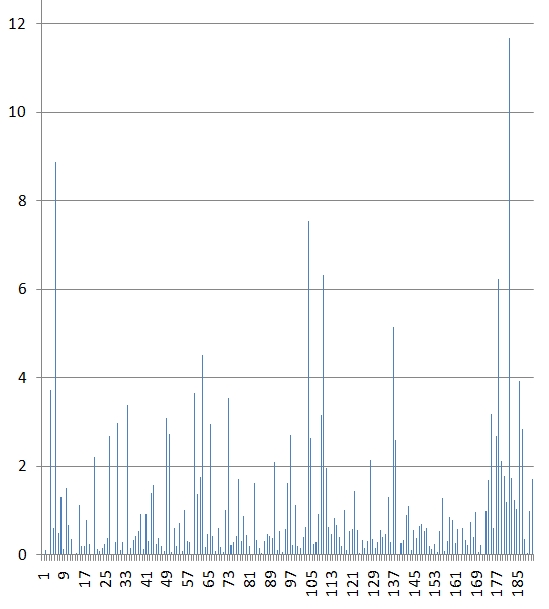
Opinion Leadership From Inside the Beltway
I am on the email list of about a dozen members of congress. Our communication goes like this:
Awful things will happen unless I am elected or re-elected. Please send money.
Iterate about 20 times.
Two year delay
Awful things will happen unless I am elected or re-elected. Please send money.
It appears that I am taken to be a very small scale ATM.
I am interested in opinion leadership, and that does not feel much like opinion leadership. I conclude that email communication is not the place to look for opinion leadership.
So I turned to congressional use of Twitter. There are two reasons for going there.
So, I need to introduce politics and opinion leadership on Twitter very briefly before turning to congressional use.
Politics and opinion leadership on Twitter
 |
This is the growth curve for Twitter messaging. In late 2008, just in time for the election, Twitter reached one million messages a day.
Only one year later messaging on Twitter was up to 50 million messages a day. In April 2010 it was 55 million messages a day, and the dramatic growth continues. There must now be more than 60 million messages a day.
The researchers at the Pew Foundation estimate that 6% of Twitter messages are about politics. Multiply 6% times 60 million and you have 3.6 million political messages a day.
That is a very impressive amount of political messaging using Twitter. And there is one more point that we need to know to assess these numbers. I have 'captured' something on the order of 5 million Twitter messages about politics. On the basis of that collection it appears that people who are messaging on Twitter have, on average, 1000 followers. Followers are people who sign up to receive everything the person they are following writes. So the average audience per Twitter message about politics is 1,000. Multiply 1,000 times 3.6 million and you get 3.6 billion. An 'audience' of 3.6 billion a day is up to 'mass media' scale. To give a concrete example -- in the last four months there have been 656,000 messages containing #teaparty. The total reach -- the number of followers for all persons writing a tweet -- is 1.4 billion. There must be a lot of redundancy in the numbers about reach. But no one has done the research to tell us how much. And even if we discount the numbers to some extent they are still remarkably big.
Notice that 'following-reach' is almost exactly what one would want to mean by opinion leadership. The person chooses to follow someone wanting to read what that person writes. They are not forced to follow. There is not only 5 or 6 possible follower relations as with TV news media. There are millions of people one might follow. And persons are free to choose any of them as their opinion leader.
So, if you were a person wanting to be elected or re-elected it looks like you might well want to enter this roaring river of messaging.
Twitter and the forthcoming election
The election is still some months away. But my review of the Twitter messages of members of congress finds few asking for campaign contributions. There are "money bombs" -- let's all get together and raise money for a candidate on a certain day. But they seem to be organized by supporters rather than by the candidates. For example, conservative Republicans all over the country used money bombs to raise funds for Scott Brown in the special election in Massachusetts, and they have lived to regret it given his voting record.
When I proposed this paper almost a year ago I thought it would be about congressional use of Twitter as the election approached, but that has been disappointing up to this point. And I have learned how impressive opinion leadership on Twitter is.
Which members of congress use Twitter?
How many members of congress have Twitter accounts? The number changes over time. There were a few leaders in 2008. There was a rush in 2009 and fewer have taken up accounts in 2010.
As of about the first of July 2010 I have a list of just over 160 members of the House who have Twitter accounts and 45 members of the Senate. For a few the data is not complete enough for analysis, but this roughly 200 members of congress is the data base for this analysis.
Which members? Christine Williams and Girish Gulati have been doing impressive research on this, and I would just refer you to their work for the answer to that question. See also the paper by Chi and Yang. I want to look instead at how members of congress are using Twitter.
Followers and Following
The 203 members of congress have 2,590,415 followers. That is a very impressive number except there is an outlier that distorts the picture. Senator McCain has 1,721,268 followers, which is 66% of all followers of members of congress. That results from his run for the presidency in 2008. And I will have to drop him from the analysis to reduce the impact of that highly unusual number.
Members of congress, excluding McCain, have 869,147 followers. That is still an impressive number. It is 4,324 apiece. The range is from 102 to 45,194. Even without McCain it is still a highly skewed distribution as shown in this figure.
 |
Only 15% have fewer than 1,000 followers, but three-fourths have fewer than 5,000 followers. Then it turns up sharply. The three leaders are John Boehner, Ohio, who is the Republican leader in the House, with 45,194 followers, Jim DeMint, Republican senator from South Carolina, has 41,215 followers, and Claire McCaskill, Democratic senator from Missouri, has 38,498 followers.
More Republicans (122) have Twitter accounts than Democrats (77), and they have an average of about 1,000 more followers than Democrats: 4,844 for Republicans and 3,935 for Democrats.
Members of congress follow as well as are followed, but the numbers are a good deal smaller. The members of congresss follow 296,969 others. That is still a pretty big number though it is not close to 869,147. The average per member is 1477, and the range is from 0 to 24,650. But there are only 18 members of congress who follow more than 5,000 people.
The point here is that when members of Congress use Twitter to send a message it is received by rather substantial numbers of people. They are potentially in an opinion leader relationship with big numbers.
An aside about messages directed to members of congress
For the most part the messages directed to members of congress are intemperate, robot produced messages. Political activists have gotten the list of usernames of members of congress, and it is pretty easy to run a program sending everyone on the list the same message.
Since members of congress understand constituents in terms of geographic boundaries, this strategy of a general mailing cannot be successful.
If that was not enough the intemperateness of the messages would convince a reader only that one would not want to read a message from the person again. One of the less vitriolic themes is
In 80 days you will be a memory .. of the Administration that tried to destroy America. @senbennelson @tomudall #tweetcongress #tcot
One does not suppose this is designed to convince Senators Nelson and Udall, but is instead a scream though it is not directed at any one person since everyone got one.
Unless you are doing research on screaming the messages to members of congress do not seem to reveal much about our politics.
Twitter messages
Followers is a necessary condition for opinion leadership, but the realization of the leadership depends on the messages. So we have to look at the messages.
The tweets go out in the name of members of congress. One might suspect that some are written by the member and others are written by staff. There are even a few members who note in the message that it was by the member or the staff. But they all are in the name of -- hence, they cannot stray too far from the member's views. So pursuing the question -- who wrote the tweets? -- does not get very far.
The number of messages range from 7 to 1570. The mean is 361 per member. The distribution is again highly skewed.
 |
There are a few high volume tweeters and the rest is a rather steady progression from 7 to 800. The high volume tweeters are: Claire McCaskill, Jason Chaffetz, Michael Burgess, John Coryn, John Boehner, That McCotter, and Tom Price. All have written more than 1,000 messages, and all are Republicans except Claire McCaskill, who is the most prolific tweeter.
But not all Twitter messages are equal. Here are four rather different styles of communicating.
The soft sell: Tom Perriello was elected to the House in 2008 from Virginia in what had been a consistently Republican district. He is following 324 and is followed by 3280. He has sent 416 Twitter messages to his followers in two years. Half of those are in the second year of his term, and those 200 are the ones examined here. In 96 he is 'selling' legislation to his constituents. What is particularly interesting in these Twitter messages is announcing 'bringing home the bacon' and attributing that to legislation passed by this congress.
It is the recovery act at work, health care reform, stimulus, and Pell grants at work right here in this district. While you would think that would be the 'bread and butter' of congressional Twitter messaging it is not.
One reason the soft sell is less in evidence than one might suppose is the overrepresentation of Republicans and the underrepresentation of Democrats among members with a Twitter account. Republicans were more focussed on the bad results of the work of the Democratic president and Democratic congress without bringing that bad news home to their own districts.
A campaign: Al Franken became the senator from Minnesota after a very long court battle about counting the votes in a very close election. He is following 2125 and is followed by 17,548. He has sent 399 Twitter messages to his followers. Almost all of them are written as statements about national policies. His is the voice of the national debate. And he is also using Twitter to wage a campaign to save net neutrality. The most recent is:
He produced 20 Twitter messages like this between August 5 and August 24. He asked followers to sign a petition, and set a goal of 100,000 signatures. And he asked that the message be retweeted, which is sent to the followers of the people reading this message.
He is the only member of congress I have found to use Twitter to organize a campaign other than a campaign for re-election. Since it is a straightforward use of Twitter it is a surprise that it is used so infrequently.
Strident partisanship from the mouth of others: John Boehner is the Republican leader in the House. His numbers of following and followers are very large: he follows 16,697, and 54,722 follow him. And he has 1353 Twitter messages. They are highly critical of the Obama administration and the Democratic congressional majority. The unusual character of his messages is the extent to which they are quotations from other sources: Via CNN, Via @rollcall, Via @politico, Michael Barone writes, Via @daytondailynews, in @bloombergnews, and @WSJ. He is re-articulating the general Republican criticism of the policies of this administration and congress for his 54,722 followers.
Down home: Don Manzullo is a Republican representing a House district in northern Illinois. He follows 118 and is followed by 1359. He has produced 523 Twitter messages for his followers. He is a Republican. There is ample criticism of the current Democratic majority. But what is distinctive about his Twitter messages is the down home character.
He is taking care of the home front. He does have speakingout townhalls where constituents can complain about the Democrats. But for the most part the focus is not on the national scene, and when it is the message is as general as taxes and lost jobs.
The point: It would be a big mistake to think that there is one way that members of congress might use Twitter to communicate with their followers. The four examples only illustrate this point. There are many other styles of communication in the use of Twitter by members of congress.
But not all styles are opinion leadership, and that is what I am interested in.
Retweeting
One indication of opinion leadership is the number of followers, which is the most direct potential audience for Twitter messages. There is a rather crude way to push the examination of opinion leadership one step further, and that is by tracking the retweeting of messages.
Retweeting is a way for someone who has read a message to send it on to their followers. Originally it was developed as a convention by users of Twitter. They developed a format -- RT @[username] followed by the original message. It is a mechanism for quoting a message and simultaneously giving credit of authorship to the person who originally wrote it. It became widely used enough that Twitter built it into the format. Originally you had to physically copy and paste. Now all you have to do is hit a button.
Retweeting is considerably more popular in political messages than in all Twitter messages. In the spring of 2009 researchers at Microsoft took a sample of all Twitter messages. They found that only 3% of the messages in their sample included a retweet. For the streams of messages I have captured the range of retweeting is from 4% to 72%. The mean is 37.5% with a standard deviation of 13%.
This is standard practice in politics. When one reads a Twitter message that 'strikes home' you send it forward to your followers.
The numbers for followers, following, and messages come directly from Twitter. They are automatically displayed on the profile page of every person with a Twitter account. However, no on does the same for retweets. If you want to know about retweets you have to collect the data, and since Twitter does not reveal its history you have to have collected it. I have been capturing all of the messages that include the username of a member of congress for a year. I can mine that collection to count the retweets of messages of members of congress. I lose eleven members from the sample because I was not able to capture their messages for this period.
 |
The total number of retweets for these members of congress is 84,517 compared to the total number of tweets for the members of 71,010. There are more retweets of members messages than there are messages. That suggests the message is getting out, which is what one would expect in assessing opinion leadership.
However, there is considerable differentiation between members. Seventy-one percent (135) of the members (192) have a ratio of tweets to retweets of less than one. There are fewer retweets than the tweets of the member. So, only twenty-nine percent have their twitter messages retweeted at a level that exceeds the number of their messages.
Ratios can give numbers that one might not want to think of as comparabe. Three is 1.5 of 2. But 3,000 is 1.5 of 2.000. One might want to differentiate the two. That is what the figure at the right does. The x axis is the number of twitter messages of a member sorted from fewest on the left to greatest on the right. The y axis is the ratio of retweets to tweets. You can see that one of the highest ratios is for a member who tweets infrequently, and the highest ratio is for a member who is in the upper echelons of tweeting. There is no simple correlation between number of Twitter messages of a member and the retweeting of those messages.
The twitter messages of only 6 members are retweeted as frequently as 5 times per message. Senator DeMint of South Carolina has the highest ratio with 950 messages that are retweeted 11,100 times. Nancy Pelosi, speaker of the House, is second with 34 tweets that are retweeted 302 times for a ratio of 8.9. Al Franken, senator from Minnesota, is third with 320 messages that are retweeted 2416 times for a ratio of 7.5. And he is followed immediately by his colleague from Minnesota Michele Bachmann with 343 messages that are retweeted 2172 times for a ratio of 6.3. The other two with ratios above 5 are less well known national figures: Mike Pence of Indiana with a ratio of 6.2 and Paul Ryan of Wisconsin with a ratio of 5.1.
It is probably worth noting that Senator McCain has sent 1430 messages to his 1.7 million followers, and they have been retweeted only 53 times for a ratio of 0.04. That does not look like opinion leadership.
Retweeting Inside and Outside the Beltway
Messages of members of congress are retweeted. Messages of people who are not members of congress are retweeted as well. I would like to compare opinion leadership from inside the beltway with opinion leadership outside the beltway. But making the comparison is not straightforward. For outside the beltway I collected streams of messages that were specified by the search term used. When I searched for #teaparty over time that became a stream of messages. To make the comparison I need to treat the messages of member of congress and the retweets of those messages as a stream. There is good reason not to add up the streams from outside the beltway so I will treat the streams of congressional messages in the same way. That gives the following table.
Percentage retweets per stream by quintile |
|||||
1 |
2 |
3 |
4 |
5 |
|
| Outside beltway | 4% - 27% |
27% - 34% |
34% - 40% |
40% - 47% |
47% - 72% |
| Congress members | 0 - 13.9% |
14% - 25% |
25.4% - 38% |
38% - 60% |
61% - 92% |
I computed the percentage of messages that are retweets for all of the outside the beltway streams and for the congressional streams. The table shows the range of retweets divided into quintiles.
For outside the beltway -- in the quintile of streams with the smallest percentage of retweets the range is from 4% to 27%. In the streams of the quintile with the highest percentage of retweets the range was from 47% to 72%.
The first row is for outside the beltway streams. The second for streams of congressional members. The difference between the two is the comparative extremes of the streams of congressional members. The lowest quintile is 0 to 13.9% for congressional streams and is 4% to 27% for outside the beltway. At the upper end the congressional streams are again more extreme with 61% to 92% compared to 47% to 72%. There are congressional streams with less retweeting, and there are congressional streams with more retweeting.
Having gotten this far the next step is looking at the content of messages to see if characteristics of the messages will explain the likelihood of their being retweeted.
Conclusion
Twitter messages are 140 characters or less. They are easy to write. You can use them to communicate the gist of an idea. They are easy to read. For many people this communication is already a part of their life style, and we can anticipate the number for whom this is true will continue to grow.
The impact of this new communication technology will depend on what people write and the potential reach of the messages. If I am a member of congress with 5,000 followers, and I send 100 Twitter messages a year that is 500,000 communications. If I write messages that lead my followers to retweet half of them to their 1,000 followers then the total reach is 5,000 followers retweeting to each of their 1,000 followers 50 times. My 100 messages become 250,000,000 communications.
© G. R. Boynton, 2010
Feng Chi and Nathan Yang (2010) Twitter in Congres: Outreach vs. Transparency, SSRN working paper series.
Williams, C. and Gulati, G (2010). Communicating with Constituents in 140 Characters or
Less: Twitter and the Di¤usion of Technology Innovation in the United States Congress. Meet-
ing of the Midwest Political Science Association.